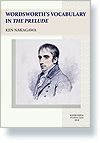検索結果一覧
Wordsworth’s Vocabulary in The Prelude


- 中川 憲



- A5

- 212

- 3,850円 (本体3,500円 )

- 2018年4月26日

- ISBN978-4-86327-437-2

- C3098

- 文学・語学/欧米〈文学〉

- 『序曲』を構成する語彙がどのようなネットワークを呈しているか、また語彙同士がどのように結びついているかを精査することでワーズワスの長編詩の核心に迫る語学的研究。(本文英文)
A linguistic study of the vocabulary that constitutes The Prelude, Wordsworth’s longest poem, in terms of its unique combination and stratificational network
| 渓水社で購入する | |
|---|---|
| オンライン書店で購入 |

- List of Tables
List of Figures
List of Charts
Acknowledgements
Introduction
Chapter 1
Vocabulary that Constitutes The Prelude
1.0 Introduction
1.1 Noun class
1.1.1 Nouns under Division 1.1 and Division 1.5
1.1.2 Nouns under Division 1.2
1.1.3 Nouns under Division 1.3
1.2 Verb class
1.3 Adjective class
1.4 Other word classes
1.5 Summary
Chapter 2
Words Combined with ‘Weight’ in The Prelude
2.0 Introduction
2.1 Purpose
2.2 Categorization of the examples of ‘weight’ in The Prelude
2.2.1 How to read the chart
2.2.2 Fourteen extracts
2.3 Examples of (A) Negative Value
2.4 Examples of (B) Positive Value
2.4.1 How to intensify the degree of ‘pleasure’
2.4.2 Finite verbs used in citation (3)
2.4.3 ‘Even’ prefixed to ‘with-phrase’
2.4.4 Brief mention of citations (9), (10), and (11)
2.5 Example of (C) Neutral Value
2.6 Observation
2.7 Summary
Chapter 3
Verbs of Perception and Cognition in The Prelude
3.0 Introduction
3.1 Verbs appearing more than ten times in The Prelude
3.2 Verbs of visual perception
3.3 Objects of verbs of visual perception
3.4 Adverbial modifiers around verbs of visual perception
3.4.1 The poet’s persistent attitude toward objects
3.4.2 The poet’s emotional state while seeing
3.5 Modifiers of ‘eye’ and ‘eyes’
3.6 Verbs of auditory perception
3.7 Objects of verbs of auditory perception
3.7.1 The poet’s keen interest in obscure ‘sound’ and ‘voice’
3.7.2 ‘Sound (s)’ and ‘voice’ tend to be qualified
3.7.3 The poet’s feeling while hearing
3.8 Modifiers of ‘ear’ and ‘ears’
3.9 Co-occurring pattern of verbs of perception and cognition:
‘saw’→‘heard’→‘felt’
3.10 Summary
Chapter 4
‘Mighty’ in The Prelude
4.0 Introduction
4.1 Adjectives in the comparative and superlative degrees
4.2 Polarized adjectives
4.3 Rearrangement of adjectives
4.4 Mirror-image relation between ‘in’ and ‘out’
4.5 Close adhesion of ‘mighty’ and ‘mind’
4.5.1 How close ‘mighty’ and ‘mind’ stand to each other
4.5.2 Sound structure of ‘mighty mind’
4.6 Summary
Chapter 5
‘Through’ in The Prelude
5.0 Introduction
5.1 Unusual rank order of ‘through’ in The Prelude
5.2 Distribution of objects for occurrences of ‘through’
5.2.1 Abstract nouns or concrete nouns?
5.2.2 “Abstract locative” nouns
5.3 Co-occurrence of ‘through’ with verbs
5.3.1 Combination of ‘roam’ with other words
5.3.2 Combination of other verbs of motion with ‘through’
5.3.3 Semantic components of verbs of motion
5.3.4 Other similar examples of verbs of motion
co-occurring with ‘through’
5.3.5 Example of a verb of visual perception
co-occurring with ‘through’
5.4 Image schema of ‘through’
5.5 Further observations of ‘through’
5.6 Reasons for the frequent use of ‘through’
5.7 ‘Through’ in the Snowdon passage
5.8 Summary
Chapter 6
Multi-Layered Structure of Expression in The Prelude
6.0 Introduction
6.1 Threefold structure
6.2 Enhancing
6.3 Deepening
6.4 Introduction to the Snowdon passage
6.5 First half of the Snowdon passage
6.5.1 Triple-layered structure representative of ‘crack’
6.5.2 Co-referential double structure
6.5.3 Subtle difference of meaning in “isotopy”
6.6 Second half of the Snowdon passage
6.6.1 Nominal equivalent structure
6.6.2 Verbal equivalent structure
6.7 Summary
Conclusion
Works Cited
Select Bibliography
Appendix
List 1.1 Alphabetical frequency list for The Prelude
List 1.2 Rank frequency list for The Prelude
Subject Index
Personal Name Index



